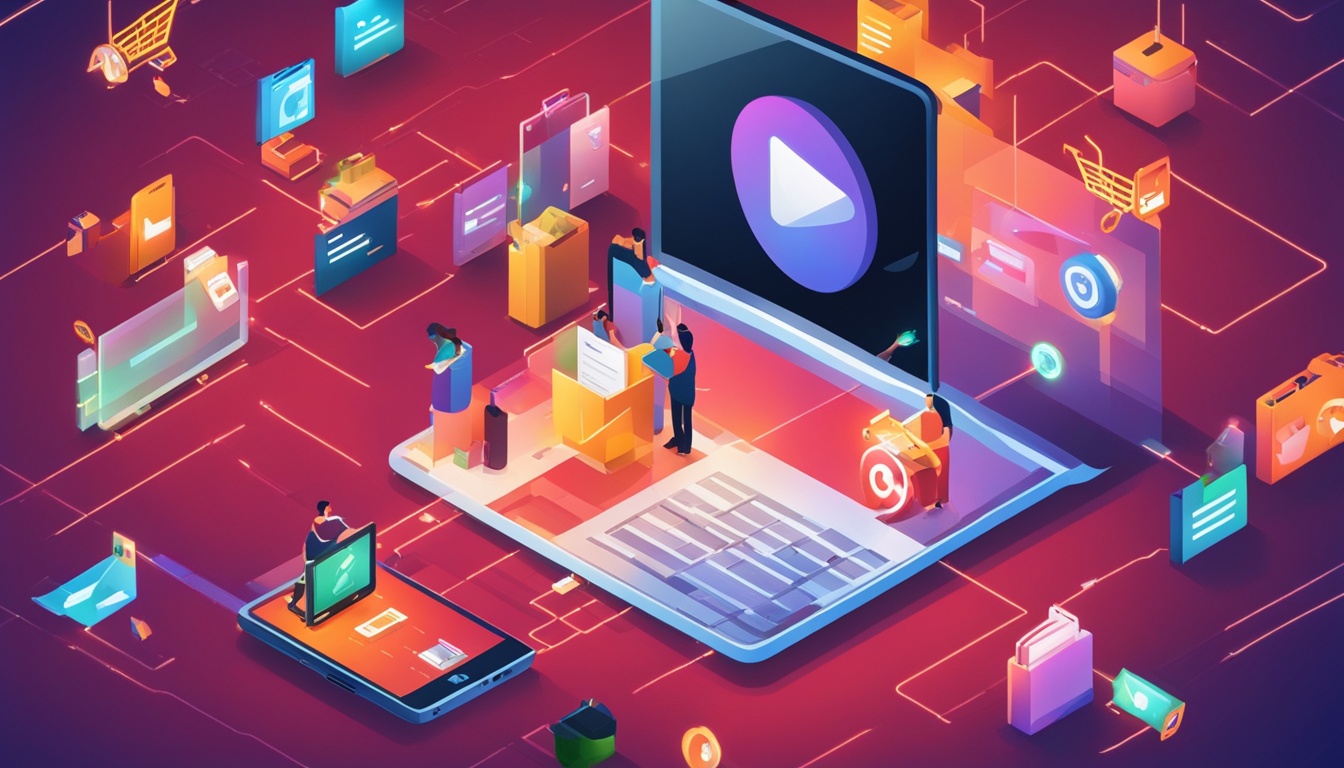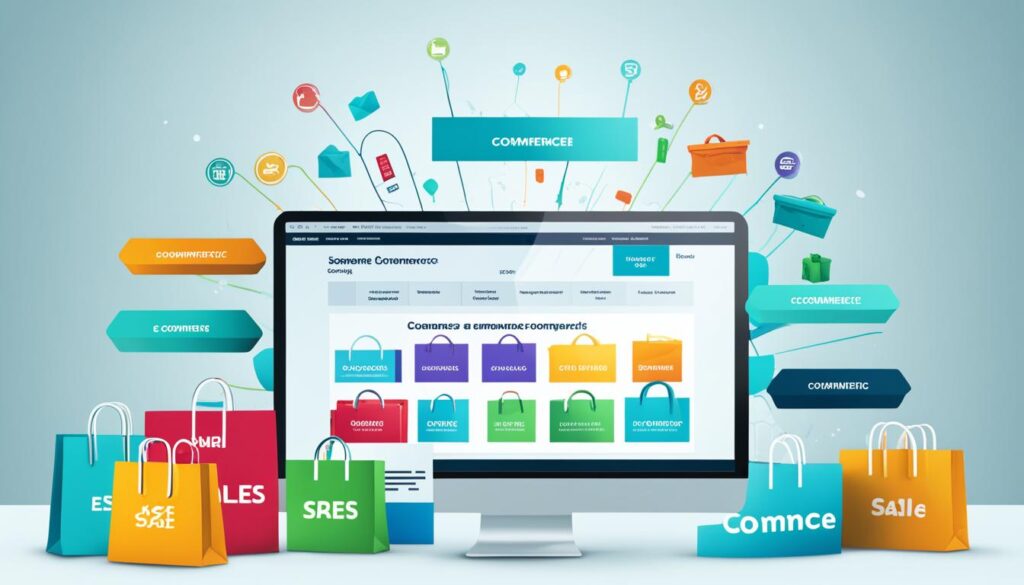
26
Aug
Exploring the Advantages and Disadvantages of Selling Digital Products Online
Have you ever thought about why so many entrepreneurs are moving to the digital product market? The e-commerce world is changing fast, and digital content is now a big part of it. As a creator, I’ve seen how selling digital products can change a business. From eBooks to online courses, there are many options. But is everything perfect in the digital world?
The digital product market is growing fast, offering great chances for smart entrepreneurs. It’s easy to reach customers all over the world with low costs. That’s why many are choosing digital content as their main product. But, like any business, there are good and bad sides to selling digital products. Let’s look at the pros and cons to understand this market better.
Selling digital products online is more than a trend; it’s changing e-commerce. Creators can reach people everywhere and deliver products right away. But, the competition is tough, and you need to be creative and strategic to stand out.
Key Takeaways
- Digital products offer global reach and instant delivery
- Lower overhead costs lead to higher profit margins
- Scalability allows for passive income potential
- The market is highly competitive, requiring unique value propositions
- Security concerns necessitate robust cybersecurity measures
- Digital products can be updated easily based on customer feedback
- Conversion-driven checkout software can boost sales significantly
Understanding Digital Products: A Comprehensive Overview
Digital products have changed how we buy and sell things online. As a creator, I’ve seen how these products have changed the digital market. Let’s explore what digital products are and why they’re getting more popular.
Definition and Types of Digital Products
Digital products are things you can’t touch that exist only in electronic form. You can access and use them on different devices. Here are some examples:
- eBooks
- Online courses
- Software applications
- Digital templates
- Audio and music files
- Digital art and photography
The Growing Market for Digital Products
The market for digital goods is growing fast. Here are some surprising facts:
| Product Category | Market Value/Projection |
|---|---|
| eBooks | $14.7 billion USD (2023) |
| Online courses | $848 billion |
| App market | $755.5 billion (by 2027) |
| US online education | $87,510.00 million (2024) |

Key Differences Between Digital and Physical Products
Digital products have big advantages over physical ones:
- Instant delivery
- No inventory costs
- Easy duplication
- Global accessibility
- Scalable business model
These benefits make digital products a great choice for entrepreneurs. They can start a business with little money upfront.
The Rise of E-commerce and Digital Product Sales
I’ve seen a big change in the digital economy lately. The online marketplace is now a giant, pushing e-commerce to new levels. By 2024, global online sales are expected to reach $6.3 trillion, showing its huge potential.
Digital transformation has changed how we do business. Starting an online store is easier and cheaper than before. Sites like Shopify help entrepreneurs reach customers worldwide, making it easier to sell across borders.

E-commerce has many benefits. Online stores are open all the time, making customers happier and increasing visits. They’re great at making people buy things on a whim and showing off top products. Plus, they can grow easily as more people want what they offer.
“E-commerce has opened doors for businesses of all sizes, offering unprecedented opportunities for growth and customer engagement.”
But, e-commerce also has its tough parts. With lots of competition, businesses need to spend more on ads to be seen. They also need tech skills to keep their stores running well. And, there are risks like cyber threats that could harm customer data.
| E-commerce Advantages | E-commerce Challenges |
|---|---|
| 24/7 Accessibility | High Competition |
| Global Reach | Technical Skill Requirements |
| Easy Scalability | Security Risks |
| Personalized Shopping Experience | Shipping Costs |
Even with challenges, e-commerce’s future looks good. As digital change keeps shaping the online world, businesses that adapt and innovate will do well in this changing digital economy.
Advantages of Selling Digital Products Online
Selling digital products online opens up a world of opportunities. It’s a game-changer for entrepreneurs wanting to reach a global audience and build a scalable business. Let’s dive into the key benefits that make digital product sales so attractive.
Global Reach and Accessibility
One of the biggest perks is the ability to tap into a worldwide market. With digital products, I’m not limited by geography. My digital offerings can reach customers in Tokyo or Toronto just as easily as those in my hometown. This global audience potential is huge for growth.
Cost-Effective Business Model
Running an online digital product store is incredibly cost-effective. I don’t need to worry about physical inventory, storage, or shipping costs. This low overhead translates to higher profit margins and the ability to offer competitive pricing.

Instant Access and Customer Satisfaction
Digital products provide instant access to customers. Once a purchase is made, delivery is immediate. This quick turnaround leads to higher customer satisfaction and repeat business. It’s a win-win for both sellers and buyers.
Scalability and Passive Income
Perhaps the most exciting aspect is the scalability. I can sell the same digital product unlimited times without additional production costs. This creates amazing potential for passive income. As my customer base grows, so does my revenue – without a proportional increase in work.
| Advantage | Impact |
|---|---|
| Global Reach | Expands customer base worldwide |
| Cost-Effective | Higher profit margins |
| Instant Access | Improved customer satisfaction |
| Scalability | Potential for significant passive income |
These advantages make selling digital products an attractive option for entrepreneurs looking to build a flexible, profitable online business.
Overcoming Inventory Challenges with Digital Products
Selling digital products changes how we manage inventory. Digital items don’t need warehouses or complex shipping. This means no storage costs and easier operations.
Digital products make delivering items automatic, making sales smoother. When a customer buys, they get their digital item right away. This quick delivery makes customers happier and cuts down on costs.
| Aspect | Physical Products | Digital Products |
|---|---|---|
| Storage Space | Required | Not needed |
| Inventory Tracking | Complex | Simplified |
| Delivery Speed | Days to weeks | Instant |
| Scalability | Limited by space | Unlimited |
Digital products are great because they can grow easily. I can sell e-books or courses to thousands without worrying about stock. This means I can make more money and reach customers all over the world.
Switching to digital products has changed my business for the better. I don’t worry about managing inventory or storage costs anymore. Now, I can focus on making great products and sharing them with more people.
The Environmental Impact of Selling Digital Products
As an eco-friendly business owner, I’ve seen how digital products are changing the game for sustainable business. The move to green e-commerce is more than a trend. It’s a key step for protecting our environment.
Reduced Carbon Footprint
Digital products greatly reduce carbon emissions. They don’t need to be made or shipped, which cuts down on pollution. This means less transportation, which is a big win for our planet.
Elimination of Physical Packaging Waste
One big plus is the lack of packaging waste. In 2018, the U.S. generated nearly 82,000 tons of containers and packaging, but only half got recycled. Digital products don’t need any packaging at all, solving this problem.
Energy Efficiency in Distribution
Distributing digital products is very energy-efficient. No need for warehouses, trucks, or planes. Everything is sent out electronically, saving a lot of energy.
| Aspect | Physical Products | Digital Products |
|---|---|---|
| Manufacturing | Resource-intensive | Minimal resources |
| Packaging | Generates waste | No packaging needed |
| Distribution | High energy use | Energy-efficient |
By choosing digital products, we’re not just running a business. We’re helping create a more sustainable future. It’s clear that green e-commerce is a powerful way to protect our environment.
Enhancing Customer Experience through Digital Product Offerings
Digital products change how we shop, making things faster and easier. Now, buyers get their items right away, which makes them happier. This digital convenience cuts out the wait time of shipping, making shopping smooth.
One big plus of digital products is how easy they are to get to. You can look at your purchases anytime, anywhere, on many devices. This lets users enjoy their content when it suits them best, making their experience better.
Digital products reach people all over the world. Sellers can sell to customers far away without the trouble of shipping. This helps the global ecommerce market grow, expected to hit $5.5 trillion this year.
| Digital Product Market | Projected Value |
|---|---|
| Global Software Industry | $608 billion |
| E-learning Market | $374.3 billion by 2026 |
| Ebook Publishing Revenue | $6.95 billion by 2025 |
| NFT Market | $41 billion |
Even with the good things about digital products, there are challenges. Things like piracy and security risks need to be tackled. It’s important to use strong digital rights management and secure downloads to protect everyone involved in this growing market.
Challenges in the Digital Product Marketplace
Selling digital products online has its own set of challenges. The market is full of competition. With easy entry, many entrepreneurs compete for customers, making it hard to stand out.
Intense Competition and Market Saturation
The digital product industry is growing fast, expected to reach $374 billion by 2026. This growth brings many sellers into the market. It makes it hard to set prices and stand out.
Pricing Strategies for Digital Products
Figuring out the right price for digital goods is hard. Digital products have low costs, but pricing them too low can be a mistake. On the other hand, high prices can scare customers away. Finding the right balance is key.
Building Trust in a Virtual Environment
Building trust online is key for selling digital products. Without meeting in person, it’s tough to keep customers loyal. I focus on great customer service, clear communication, and quality products that solve real problems.
Overcoming these challenges requires being adaptable and innovative. By understanding the market and focusing on what customers need, it’s possible to succeed in the digital product market.
Security Concerns and Intellectual Property Protection
Selling digital products online brings its own set of challenges in cybersecurity and data protection. As creators, we must protect our work and customer info from threats.
Digital rights are key for online sellers. Did you know copyrights protect your work for the author’s life plus 70 years? This long protection lets creators keep control over their work for many generations.
Copyright infringement is a big risk in the digital world. To fight this, I suggest using strong security steps:
- Use watermarks on digital products
- Implement secure payment gateways
- Regularly update software and systems
- Educate customers about proper usage rights
Trade secrets don’t need formal registration and are cheap to make. This makes them a good choice for protecting some parts of digital products.
| Intellectual Property Type | Protection Duration |
|---|---|
| Patents | 20 years from filing date |
| Copyrights | Life of author + 70 years |
| Trademarks | Indefinite with maintained registration |
| Trade Secrets | Indefinite without registration |
By focusing on cybersecurity and knowing about intellectual property rights, we can make a safer place for creators and buyers in the digital product market.
Marketing Strategies for Digital Products
In the digital product world, marketing is crucial for success. A blend of strategies helps sellers stand out and draw in customers. This is key in a crowded market.
Leveraging Social Media and Content Marketing
Social media is a strong tool for marketing digital products. By sharing engaging content, I can reach more people and build my brand. Content marketing, like blog posts and videos, makes me an expert in my field. It also brings more visitors to my products.
Email Marketing and Customer Retention
Email campaigns are vital for growing leads and keeping customers. I send personalized emails to keep my audience interested. I offer special deals and encourage buying again. This method is affordable and brings a good return.
Search Engine Optimization for Digital Products
SEO is key for making my products easy to find online. I make my product descriptions better and create relevant content. I also get quality backlinks to help my rankings and bring in more visitors.
| Marketing Strategy | Effectiveness | Cost |
|---|---|---|
| Social Media Promotion | High | Low to Medium |
| Email Campaigns | Very High | Low |
| SEO for Digital Products | High | Medium to High |
Using these digital marketing strategies has greatly improved my product’s visibility and sales. It’s vital to keep updating and improving these methods. This helps me stay ahead in the fast-changing digital world.
Advantages and Disadvantages of Selling Digital Products
I’ve explored the digital product sales world and found both good and bad sides. Let’s look at what entrepreneurs should think about when starting in this field.
Selling digital products can lead to high profits. With low costs, profits can go over 85%. Plus, you can sell to people all over the world, 24/7, without worrying about where they are.
But, the competition is tough. Only the top sellers make good money, and many face issues like piracy and too many choices. It’s key to make unique, quality products and market them well to stand out.
| Pros | Cons |
|---|---|
| High profit margins (85%+) | Intense competition |
| Global reach | Risk of piracy |
| Low startup costs ($12-$27,209) | Platform fees and commissions |
| Quick setup (few hours for beginners) | Lack of physical appeal |
When looking at online business options, think about how digital products offer flexibility and growth. But, starting can take a lot of time and effort. Still, the chance for passive income and working from anywhere makes it appealing for many entrepreneurs.
“The digital product marketplace offers immense opportunities, but success requires strategic planning and persistent effort.”
By looking at both sides, you can decide if selling digital products fits your business goals and what you can do.
Future Trends in Digital Product Sales
The future of e-commerce is changing fast, thanks to new tech and how people shop. I see big changes coming in how we buy things online.
Emerging Technologies and Their Impact
Artificial intelligence and virtual reality will change digital product sales a lot. They will make shopping online more fun and personal. For example, 63% of companies now use digital tools to work better.
Changing Consumer Behaviors and Preferences
People want things they can use right away and that fit their needs. Working from home has made this need even stronger. Now, companies use data to quickly change what they offer to meet these needs.
Predictions for the Digital Product Market
The market for digital products is expected to grow a lot. The eLearning market could be over $370 billion by 2026. This means big chances for those making online courses, digital planners, and other digital products.
“Digital platforms have enabled small startups to have the same global reach as multinational corporations.”
Looking ahead, we’ll see more digital products in e-commerce. They can make a lot of money and grow easily, so they’ll likely be a big part of online shopping soon.
Conclusion
Looking at the digital product world, I see huge opportunities for entrepreneurs. Online sales are set to beat offline sales in the US by 2021. This change is a big chance for success in the digital market.
Digital products have big advantages. They cost less to run and need fewer people. Marketing them is cheaper, using social media and email. Plus, you can make more copies without extra cost, which means more money.
But, there are also challenges. Things like piracy and tough competition online need smart plans. Building trust is key since people worry about security. But, with the right steps, these problems can be solved. Digital products can reach people all over the world and are seen as valuable, making them a great choice for new entrepreneurs.
In the end, the digital product world is full of potential. As we go forward, those who take on these chances and tackle the challenges will likely do well in the changing digital market. The future of e-commerce is digital, and it’s here.
FAQ
What are digital products?
Digital products are things you can’t touch that you buy and get online. Examples include eBooks, online courses, software, and more. They’re things like audio files, photography, and games.
What are the key advantages of selling digital products online?
Selling digital products online has many benefits. You can reach people all over the world easily. It’s also cost-effective and lets you make money without extra work.
You can share your products instantly, and they don’t take up space. This means you can make more money with less effort. Plus, you can sell to people all over the globe with just a few clicks.
How do digital products eliminate inventory management challenges?
Digital products don’t need storage or shipping. This cuts down on costs a lot. You don’t have to keep track of inventory because you can send out digital files as people buy them.
What are the environmental benefits of selling digital products?
Selling digital products is good for the planet. It cuts down on waste and pollution by avoiding the need for manufacturing and shipping. Using digital products means using fewer resources than making and shipping physical goods.
How do digital products enhance customer experience?
Digital products make things easy and fast for customers. They can get to them anytime, anywhere, on many devices. This lets customers enjoy content when they want, where they want, which makes them happier.
What are some challenges in the digital product marketplace?
There are a few hurdles in selling digital products. For example, there’s a lot of competition and figuring out the right price. You also have to build trust online and keep your products safe from hackers.
Another challenge is dealing with piracy, which means people sharing your products without permission.
How important are marketing strategies for selling digital products?
Marketing is key to selling digital products well. You need to use social media, content marketing, email, and SEO to reach people. This helps you stand out and draw in customers.
What are some future trends in digital product sales?
The future of selling digital products will likely involve new tech like AI, VR, and blockchain. We’ll also see changes in what customers want, like more personalized content and experiences.
Author
Sabrina is the insightful author behind the blog at The Digital Publishing Center. With a deep passion for digital product creation, publishing, and leveraging AI tools, she specializes in enhancing the development of ebooks, courses, and other digital resources. Sabrina's expertise lies in transforming innovative ideas into engaging, high-quality content, helping creators and educators elevate their offerings in the digital space.








